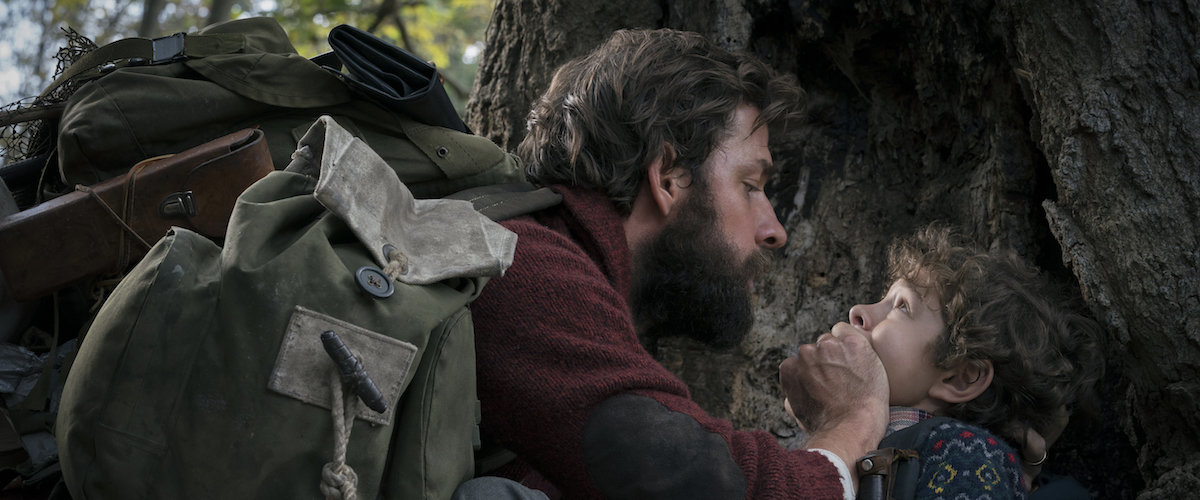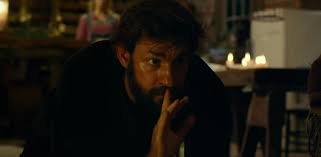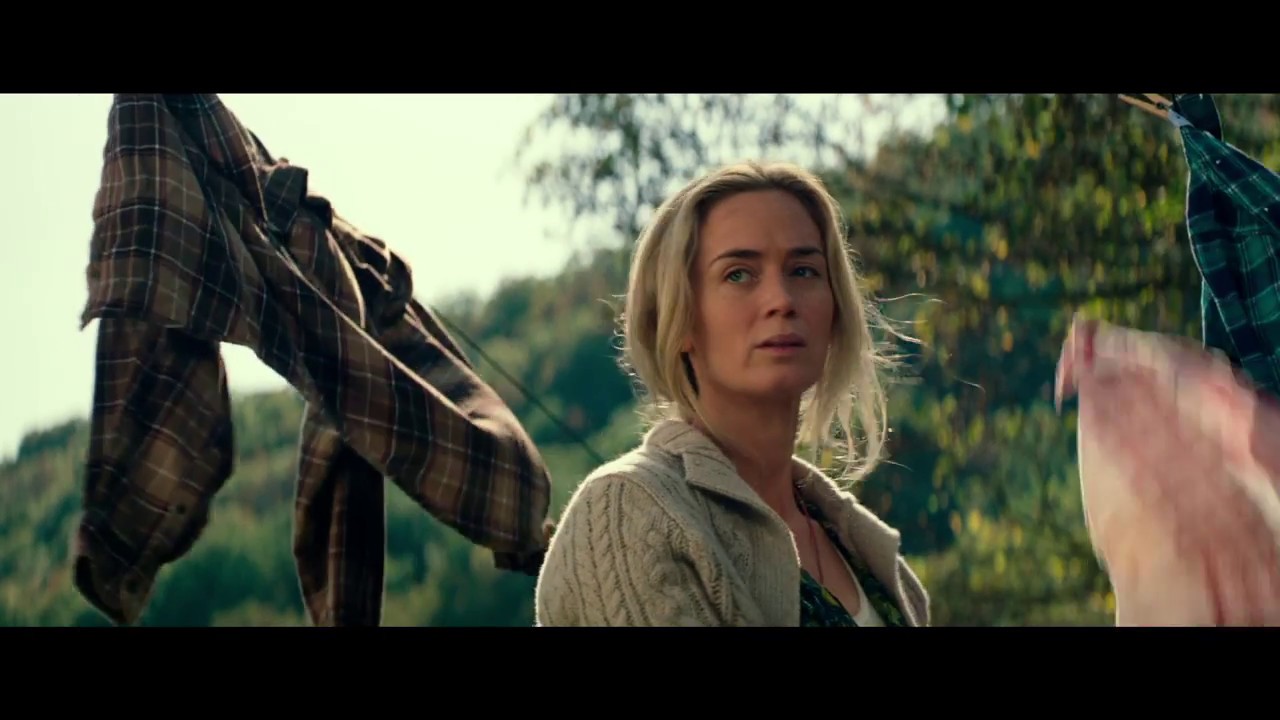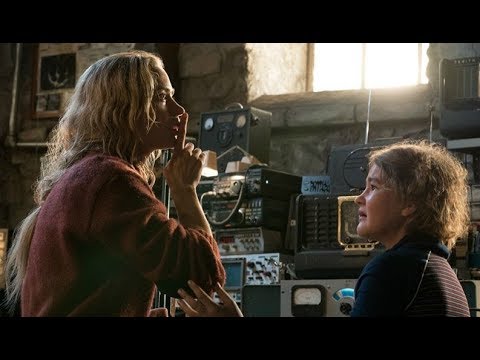John Krasinski’s A Quiet Place is a film founded on the very idea of sound and its place in cinema. Set in a post-apocalyptic wasteland, prowled by monsters that act on their extensive hearing abilities alone, the film necessitates silence for a large majority of its run time. The characters go to great lengths to perform tasks as quietly as possible, they speak using sign language for the majority of the film, and even the slightest of noises could mean death. So why can’t the movie be quiet?
Take, for instance, the moment when Krasinski’s Lee and his son, Marcus, out catching fish and grabbing supplies for the family, stumble upon a man in the middle of the woods. The man is standing over his dead wife and looks petrified. Lee comes to the realization that the man is in incredible distress and silently begs him to remain quiet. The man’s face contorts violently, as he takes in a deep gasp of air before letting out an ear-splitting scream. Lee has to move quickly, picking Marcus up and running for cover as quickly and silently as he can as he hears the monsters descending upon the man and tearing him to shreds.

That sounds utterly horrifying but that’s not what audiences who turned out to see A Quiet Place in theaters this weekend got to experience. What the audience experiences instead of this scene is a quick jump scare when they stumble upon the man, and then a loud, obnoxious, over-the-top, and generic soundtrack telegraphing the sequence’s every move to the audience in the clumsiest of ways. We feel no tension or suspense at the notion of whether or not the man is going to scream because the rising crescendo of the score makes it painfully obvious. Rather than experiencing the deafening silence with the characters, ears acutely listening for any and every sound the monsters might pick up on, we are removed from the moment by a horror score that drowns out the diegetic sound.
Which is a shame, because the sound design here is immaculate. Early moments that feature cutting back and forth between Lee and their deaf daughter, Regan, or Lee putting on headphones play with sound and silence in positively thrilling ways. The film goes to great efforts to put us in the mindset of the characters in the film, hearing specifically what they hear and therefore experiencing the film in a more visceral and personal way. But then it goes and chucks all this hard work out the window at the first sign of actual plot or scares.
In the movie’s final act, there’s a sequence in which the son and daughter are inside of a truck as one of the monsters attacks. The sequence begins with the daughter turning off her hearing aid, cutting the sound to total silence for her and for us. The monster rears up right outside of the window, in what is easily one of the most chill-inducing moments in the film, and then attacks. But when it attacks, the sound comes crashing back into the mix, louder than ever. Rather than immersing us in the daughter’s mindset for the whole of the sequence, the film opts to go for a cheap and easy jump scare instead, that adds nothing to the film.

In the bigger picture, scores are there to guide an audience through the film. The music can provide resonance and added layers to beats and events in the film when the two work in tandem together. But here, the score works in opposition to the film itself. In many ways, it feels as though there is a cut of the film with minimal score usage, but that someone behind the scenes was nervous the quieter version of A Quiet Place wouldn’t be as commercially successful.
Which is probably true. Krasinski himself has said that the original script for the film only had one line of dialogue. That was beefed up in the final film, to include a full conversation between Lee and Blunt’s Evelyn, in which the two articulate the overall theme of the film. So there’s a fine line between the quiet, strange, and dark film A Quiet Place could have been and the more commercial one that is playing in theaters.
The soundtrack is far from the only victim of this commercialization. The edit of the film itself feels jagged and a bit uneasy at times with its own content. In the aforementioned sequence where Lee and Marcus find the distressed old man in the woods, the camera begins to pan down to show his dead wife’s mutilated body, only to suddenly cut off in the middle of the camera movement. It’s a disjointed move that doesn’t feel intentional but rather mandated.
Other early sequences feel as if they’re being sped through in the interest of not boring the audience. A quiet moment in which the family sits around the dinner table, holding hands and praying in total silence is a powerful one. They cannot speak to one another, so they all share a moment of silent individual prayer as a family. But the film seems to have little interest in this as it relates to the characters or the plot; the camera is constantly moving and the edit doesn’t hold a single shot of it longer than five seconds. So this quiet, intimate moment of peace just flies right on by, never really being given a moment to breathe or resonate.

Then there’s the ending, which is perhaps the easiest example of these two potential versions of the film clashing up against one another. After discovering the monsters’ weakness is sound, Regan utilizes it against one of them, by turning her hearing aid up to full blast and playing it through a microphone. The frequency overwhelms the monster, sending it into convulsions before it collapses.
This is a solid resolution in many ways. Regan overcomes her grief for being responsible for her younger brother’s death at the start of the film, the hearing aid that Lee keeps attempting to perfect for her (a visual symbol of his love) is what she uses to overcome the monster, and it makes narrative sense that this is a weakness that no one would have necessarily thought to exploit before.
But then it keeps going.
The monster stands back up, apparently realizing it must adhere to the horror movie villain handbook, and charges at them. Blunt responds by shooting the creature in the head with a shotgun, which kills it for good. Not only does this undermine every character-based resolution they just had, it makes zero narrative sense. The events of this film are taking place a year-and-a-half after these monsters showed up and took over the world, but apparently, no one had ever tried just shooting them during that time. It’s a strange move in so many ways, turning both the narrative and the film’s morale away from family and more towards guns.

The film then officially ends with Blunt and the family seeing the remaining two monsters running towards the house on their security cameras, as Blunt looks in the camera and cocks her shotgun.
What started as a quiet and intimate horror film slowly evolves over its runtime with little switches here and there. The edit moves key moments along at a pace faster than necessary, the soundtrack grows increasingly loud and overactive as the horror elements take hold in the second and third act, the impeccable sound design grows less important, and we are left with a near-perfect ending that gives way to an utterly nonsensical one.
All of which is a genuine shame because A Quiet Place is not an awful movie. Far from it, it is a well-directed, well-written, and well-acted film that is working off of a great concept. But its commitment to being a more commercially-minded horror film prevents it from attaining the greatness within its reach.